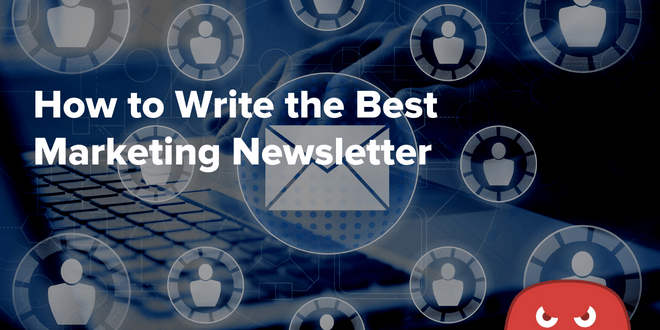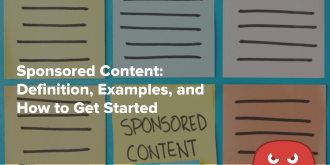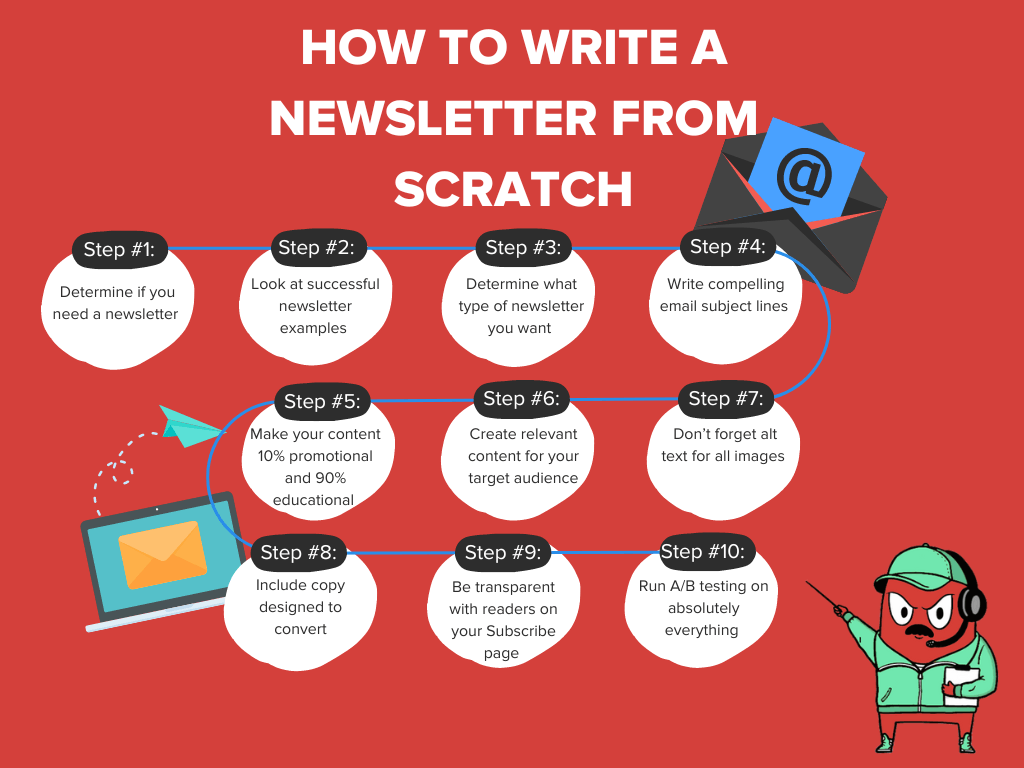Quick Links
Email is still one of the most effective marketing channels, as it’s able to generate $45 for every $1 spent (a whopping 4,500% ROI).
That’s why email newsletters are such a popular tactic for businesses, despite floundering open rates. As of 2022, email open rates (including newsletters) dropped from 21.3% in 2021 to 16.97%.
What gives?
It’s a combination of a few factors – primarily waning user attention spans and inboxes that are bursting at the brim with junk mail.
That means you really need to knock it out of the park if you want anyone to read your weekly newsletter.
It takes a lot more than sharing general industry news and your latest blog posts. Instead, you need to release relevant content that directly impacts your target audience and compels them to take further action through CTAs and strong messaging.
You’ll also improve your ROI if you implement a/b testing, infographics, dynamic content, and new product showcases.
Essentially, a great newsletter in today’s age takes a bit more effort than before, but the results are well worth it.
If you aren’t sure how to write a newsletter, you’ve come to the right place. We’ve put together an extensive guide containing tips on how to construct the ultimate weekly or monthly newsletter.
So if you’ve never written a newsletter or your current one is seeing too many users unsubscribe, read on to learn how to produce stellar newsletter content.
Who Reads Email Newsletters the Most?
First, you need to know who to target with your newsletters in order to produce the right content.
For instance, if you focus your efforts on acquiring new customers with your content, you may end up neglecting existing customers, which will likely account for most of your newsletter subscribers.
This study by SparkPost and SurveyMonkey found that email marketing techniques are most effective for your existing customers post-purchase.
Why is that?
It’s because your existing customers want to learn more about the product or products they bought, which is why they have a vested interest in signing up for the newsletter.
That gives you the golden opportunity to nurture them as a customer with your content, showing off new products and upgrades they can also buy. In other words, you’ll find more success focusing on upsell revenue instead of revenue from new customers.
That doesn’t mean you can’t focus some of your email marketing strategy on lead generation and conversions, as transactional emails that trigger during the sales process are always a good idea. Yet, newsletters reign supreme at nurturing, upselling, and re-converting your existing customers.
Newsletter Content That Caters to Existing Subscribers
Since most of your readers will be existing customers/subscribers, your content should reflect that. If your newsletter assumes its readers are just learning about your brand, you could wind up alienating your primary reader base.
Here are some content ideas that will keep your subscribers and customers engaged:
Ask for feedback
Newsletters aren’t just your chance to speak to your customers; you can also hear from them.
Encourage your readers to give feedback on their satisfaction levels, ideas, and opinions of your content/products.
Beyond that, do what you can to follow up on the feedback you receive to show your readers that you’re actively listening.
That’s one of the most reliable ways to build customer loyalty, as 90% of Americans cite a positive customer service experience as one of the primary factors for doing business with a company.
Educate subscribers
The primary reason existing customers sign up for newsletters is to learn more about your products and services, so don’t deprive them of that.
Produce newsletter content that educates customers on features of your products they may not know about to increase upsell revenue.
The proof?
Research shows that educational content makes consumers 131% more likely to buy, so don’t be shy about getting in front of the chalkboard for your subscribers.
Promote new discounts, deals, and promotional offers
Not only do customers love this type of content, but it’s a great way to increase your ROI.
If you’re about to run a new promotional offer at your company, make sure to bring it up in your newsletter.
You can also offer exclusive discounts and offers for newsletter subscribers only as a way to incentivize new sign-ups. If potential customers see that they can receive a discount on your products or services by signing up, they’re far more likely to do so.
Share testimonials and personal stories
Your newsletter should also connect with subscribers on an emotional level as well. Sharing real customer testimonials as well as raw, personal stories will build loyalty amongst readers.
Not only that, but a powerful testimonial can convince existing customers to try new products and services that you offer. If your narrative storytelling is strong and your call-to-action is convincing, you stand the greatest chance of boosting conversion rates.
Include dynamic content
If you have the budget for it, including dynamic content is one of the best ways to improve your email marketing ROI.
What’s dynamic content?
It’s any type of content that changes based on data, user behavior, and preferences. In the case of email newsletters, you can use dynamic content to display personalized content for each subscriber.
That personalized content can include all sorts of fun things, such as:
- Messages addressed directly to the subscriber by name
- Specific sections of the newsletter that only certain subscribers can see
- Users’ current weather forecast, favorite bands, and more
Companies like Netflix use dynamic content in their emails that allow users to pick up where they left off streaming a particular series, which is convenient for users and helps boost Netflix’s streaming numbers.
Try to personalize your newsletter in any way that you can to form a deeper connection with your readers. In fact, 80% of consumers are more likely to do business with a company that offers personalized experiences – which is a testament to the power of dynamic content.
How to Write a Newsletter from Scratch
The reason email open rates are down is that too many marketers haven’t worked on their email content in years. They’re still sticking to bland newsletters that don’t offer much to the modern internet user.
Sharing industry news updates they can get elsewhere isn’t a good idea, nor is copying and pasting existing content from your site (i.e., blog posts and landing pages).
If you want to knock your next newsletter out of the park, you need to take your content game to the next level if you want higher open rates, click-through rates, and conversions.
To help you out, here’s a step-by-step guide to creating the best newsletter you’ve ever released.
Step #1: Determine if you need a newsletter
Email newsletters aren’t right for everyone, so you should do some marketing research to determine if a newsletter is worth investing resources into or not.
First, check to see if there are successful newsletters within your industry that have a large number of email subscribers.
If you can’t find any, it’s a sign that newsletters don’t vibe well with your target audience.
However, if you can find some winning newsletters in your field, pay close attention to what they’re doing right.
Ask yourself the following questions:
- What type of content do these newsletters regularly release?
- Do they make use of dynamic content?
- Is it feasible for your company to produce similar types of content with your budget and internal team?
If you have faith that you’re able to replicate and even outdo the best newsletter examples in your niche, it can be well worth the investment.
You should also consider what you want to achieve with your newsletters. For example, do you want to use it as a lead generation tool, or are you more concerned with customer retention? Setting your goals early on will help you stand a better chance of achieving them.
If you find that a newsletter isn’t right for your company, you could focus the resources on blog content or email nurturing campaigns instead.
Step #2: Look at successful newsletter examples
One of the best ways to find inspiration is to take a look at some high-quality newsletters that are doing it right.
Looking at newsletter examples will help you come up with ideas for:
- Layout
- Graphic design
- Segmentation
- Writing style
There are also plenty of newsletter templates that you can use as jumping-off points. While focusing on newsletters within your niche is a good idea, looking at ones from other industries can spark some creative ideas you may not have thought of otherwise.
This example from Peter Thomas Photography is an excellent example of a classic-style newsletter that has some unique touches. It focuses on their services and encourages subscribers to book a session – but the copywriting has a warm, friendly tone.
The cute image of the dog at the top also attracts the eye, while the heading that says Clearance Sale – almost all gone elicits a strong sense of urgency for customers.
Step #3: Determine what type of newsletter you want
A mistake a lot of newsletters make is similar to companies not choosing a niche – they lack a specific focus, so they end up with cluttered content that tries to please everyone.
Just as you select a target audience for your company, you also need to choose a theme/focus for your newsletter.
Otherwise, your emails will try to please everyone and end up pleasing no one.
What types of newsletters are there?
Here’s a look at the most common types of email newsletters.
Company email newsletter
These newsletters are typically for company employees only. Instead of generating leads or nurturing existing customers, these newsletters keep your staff informed of essential company news, policy updates, and crucial internal information.
Besides informing your employees, company newsletters can also boost morale by highlighting staff achievements with letters of appreciation and other rewards.
If you’ve been looking for a way to boost employee engagement, a newsletter is a great way to do so.
The benefits?
An engaged workforce can boost profitability by 21%, so a high-quality company newsletter can be well worth the investment.
Practical newsletters
A practical newsletter is all about providing your audience with quick, helpful tips on your products and services.
It’s a straightforward way to educate your customers without overstaying your welcome.
These newsletters tend to feature short blocks of text and minimal graphic design to enhance readability. As a result, these emails are very easy for audiences to digest, which will increase the chances of them actually reading the whole thing.
To see an excellent example of a practical newsletter, check out this one from the New York Times.
It contains one initial block of text at the top, and the rest consists of pictures, graphics, and quick snippets of text users can click on for more information about the top stories of 2017.
Blog-style newsletters
If you want to go a bit more in-depth with your informative/educational content, you can try a blog-style newsletter.
It’s not enough to simply link your most recent blogs, though, as that’s a bit too bland for modern audiences.
Instead, do your best to make the format as visually appealing as possible with colorful infographics and high-resolution images.
Also, you need to carefully curate the blogs you include in each release, as it needs to relate directly to the needs of your subscribers. For instance, if sales for a particular product are up, you can include a blog educating customers on its key features in your next newsletter.
Here’s a great example of a blog-style newsletter that doesn’t overstay its welcome.
As you can see, it only highlights two blog posts that relate to their audience (digital marketers), separated by an infographic and company logos that use their software.
Each blog post also has a brief summary of what it covers, which lets subscribers know if the content is up their alley or not.
User-generated newsletters
Readers love to feel heard and valued, which is why user-generated newsletters are so valuable.
A user-generated newsletter consists entirely of content from users – such as reviews, case studies, testimonials, surveys, and user feedback.
These types of newsletters are fantastic for making your readers feel like they have an active stake in your brand and that you listen to and value their input.
We’ve already mentioned how an engaged audience is more likely to buy, so this type of newsletter is definitely something to consider.
Visually-oriented newsletters
Using visuals over text will improve retention and engagement, according to research. It’s been found that our brains process images 60,000 times faster than text, so they’re a powerful tool to use in your newsletters.
Instead of educating customers with a simple blog post, why not transform it into a fun infographic instead?
Or you could embed a video educating customers on your new products and services as a way to increase engagement.
In short, the more images you can include in your newsletter, the better.
Boosting your email open rates is all about standing out from the crowd, and infographics/images/videos are a great way to do so.
If you really want to be original, why not try creating video newsletters where everything is either an animated GIF or a live video (assuming you have the budget)?
Curated email newsletters
These types of newsletters involve curating a great deal of helpful content for your audience and putting it all in one place.
These newsletters are great because they’re a caring gesture for your subscribers. Instead of having to scour the internet to find specific articles, links, and resources – you provide all of them in one convenient location.
What type of content can you curate for your audience?
It could be anything, from helpful online resources (job boards, government entities, licensed doctors in a specific area, etc.) to funny Twitter and Reddit posts to entertain your readers.
Of course, you should only curate content that directly relates to the needs and desires of your subscribers; otherwise, it will be a waste of time.
Step #4: Write compelling email subject lines
Your subject line serves as the first impression for your email to users, so it needs to hook their interest immediately. Nobody will open your newsletter to read your amazing content without an interesting subject line.
As a rule of thumb, keep your subject lines between five to seven words if possible (yet it’s essential to a/b test them with your audience to see what resonates).
You should also avoid phrases that may trigger a user’s spam filter, such as cheap, sale, clearance, buy, money, and cash are common trigger words for spam. They also aren’t very intriguing for customers, so avoid them at all costs.
Compelling headlines include:
- A question that you answer in the body of the email
- Helpful tips that intrigue readers to learn more
- Make an announcement
These are all great ways to generate interest in your header.
Step #5: Make your content 10% promotional and 90% educational
Constant self-promotion is a surefire way to get readers to hit the unsubscribe button. Remember, your subscribers mostly consist of existing customers, so they don’t want to read about your products and services all the time.
Instead, dedicate the majority of your content to informing and educating customers.
For instance, if you sell t-shirts, don’t make your entire newsletter about the shirts you have for sale.
Instead, include information about new t-shirt fashion trends and ways to pair t-shirts with other clothing items. That will be far more valuable to your readers, and they’ll be more willing to digest the 10% of your newsletter that is self-promotional.
Step #6: Create relevant content for your target audience
You need to understand what your target audience wants to find the most success with your newsletter.
That means studying your demographic metrics and creating a customer avatar if you haven’t already. Once you understand your audience’s wants, needs, and pain points, you’ll be able to create content that they actually want to consume.
To boost your ROI even further, you should try segmenting your audience into different groups and sending different versions of your newsletter to each one. Marketers that do this report a whopping 760% increase in revenue – so it’s a great tactic to mimic.
You can segment your audience by:
- Behavioral
- Geographic
- Psychographic
- Demographic
Doing this will personalize your newsletter content, which we’ve already established is great for business.
If you segment your audience by geography, for example, you may include different products based on where they are (i.e., including swimsuits for subscribers that live near the coast), which will make them more likely to buy.
Step #7: Don’t forget alt text for all images
A staple of on-page SEO, alt text for images applies to email newsletters as well.
What’s alt text?
It’s a line of text that describes an image, both for the seeing impaired and for Google’s crawlers (they can’t see images, so they need the alt text to infer what an image shows).
Whereas you add alt text for the crawlers on your web content, you need alt text in your newsletters for your readers.
That’s because not everyone has images enabled for their email. As such, alt text is crucial if you want your audience to know about your images. That’s especially true for images that serve as calls to action, as you want your subscribers to be able to see it/click on it even if they don’t have images enabled.
Step #8: Include copy designed to convert
What kind of copy is most likely to convert?
Is it lengthy jargon that consistently begs users to buy your products?
No.
Is it formal copy written in a stiff, professional tone that ultimately says nothing?
No.
What is it, then?
The best type of copy is written as if you’re talking to a friend. A warm, conversational tone with plenty of humor is a great way to draw in your audience.
Also, shorter is always better.
You want short paragraphs containing short sentences (and maybe even short words).
Last but not least, you can’t forget the call to action. After all, if you don’t tell your readers what you want them to do, how will they know? Whether you want them to give you feedback or sign up for a new promotion, include a clear CTA at the end of your copy.
Step #9: Be transparent with readers on your Subscribe page
Once you’ve got your newsletter in order, you need to get your subscribe/sign-up page ready, complete with copy describing what users can expect.
It’s crucial to be completely transparent here. In plain English, let your prospects know exactly what they’ll find in your newsletter, as well as how often you’ll release them.
Don’t overpromise here, as not being truthful about your content will only lead to readers unsubscribing once they realize they aren’t getting what they were promised.
To entice users to subscribe, include a brief preview of your newsletter on your sign-up landing page. That can help encourage some users to subscribe who were on the fence because they weren’t sure what the newsletter contained.
You should also make it effortless for your readers to unsubscribe, as counterintuitive as it may seem.
Why is that?
Beyond common decency, it also has to do with the way email providers mark messages as SPAM or not. Without a clear unsubscribe button (by using tricky language like changing how you communicate with us), providers like Gmail may flag your newsletter as SPAM, so beware.
Step #10: Run A/B testing on absolutely everything
Last but not least, you need to A/B test your newsletter – including all dynamic and segmented content.
Brands that A/B test their email marketing content see an ROI that’s 82% higher than those that do not, so it’s a crucial step to take if you want to see maximum returns.
You can test every part of your content, from the header to the body to the CTA. All you need to do is release two different variants and see which performs better with your audience. To test your headers, the second newsletter should only contain a change to the header and so on.
Many email providers have built-in A/B testing that you can use, such as Gmail.
Final Thoughts: How to Write a Newsletter
By now, you should know how to write a newsletter from start to finish. Existing customers read newsletters by a large margin, so you should focus the majority of your efforts on them.
Email marketing campaigns are still one of the most reliable and cost-effective ways to generate revenue for your business, so you should very much start a newsletter.
If you focus on creating A/B-tested content relevant to your audience with copy designed to convert, you’ll stand the greatest chance of success.
Do you not have time to create content at your company?
Then don’t wait to check out our high-quality content writing service today.










